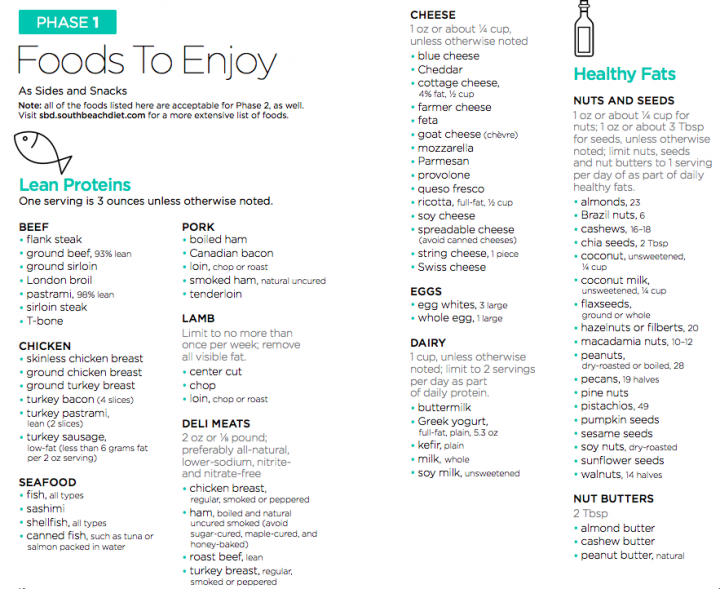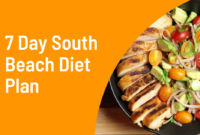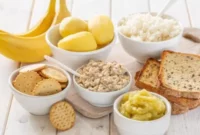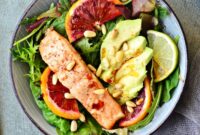South Beach Diet Phase 1 foods you can eat represent a crucial starting point for this popular weight-loss plan. Understanding which foods are permitted and which are restricted is key to successful implementation. This phase focuses on eliminating refined carbohydrates and added sugars, prioritizing lean protein, healthy fats, and non-starchy vegetables to stabilize blood sugar levels and promote weight loss. We will explore the foundational principles of Phase 1, delve into specific food choices, and offer practical guidance for navigating this initial stage.
This detailed guide provides a comprehensive list of allowed foods, categorized for clarity. We’ll examine the nutritional benefits of each food group and offer creative serving suggestions to maintain interest and adherence to the plan. Furthermore, we address common challenges encountered during Phase 1, providing practical solutions to overcome obstacles and maintain long-term success.
Allowed Foods
The South Beach Diet Phase 1 emphasizes lean protein sources, non-starchy vegetables, and healthy fats to jumpstart weight loss and improve metabolic health. This initial phase focuses on minimizing carbohydrate intake to regulate blood sugar and curb cravings. Understanding the role of each food group is crucial for successful adherence and optimal results.
Lean Protein Sources
Lean proteins are essential for building and repairing tissues, maintaining muscle mass, and keeping you feeling full. Adequate protein intake is vital during Phase 1, as it helps prevent muscle loss while promoting weight loss. Aim for approximately 4-6 ounces of lean protein per meal.
- Chicken Breast: Grilled, baked, or poached chicken breast is a versatile and readily available lean protein option. A 4-ounce serving provides approximately 30 grams of protein.
- Fish (Salmon, Tuna, Cod): Rich in omega-3 fatty acids, these fish are excellent sources of lean protein. A 4-ounce serving typically contains 20-30 grams of protein.
- Lean Ground Beef (90% lean or higher): Choose lean ground beef to minimize fat intake. A 4-ounce serving provides around 25 grams of protein.
- Eggs: Eggs are a complete protein source, providing all essential amino acids. Two large eggs offer approximately 12 grams of protein.
- Turkey Breast: Similar to chicken breast, turkey breast is a lean and flavorful option. A 4-ounce serving provides approximately 30 grams of protein.
Non-Starchy Vegetables
Non-starchy vegetables are low in calories and carbohydrates while being rich in vitamins, minerals, and fiber. Their high fiber content promotes satiety, helping you feel fuller for longer and reducing overall calorie intake. Incorporating a wide variety of non-starchy vegetables is crucial for maximizing nutritional benefits. Aim for at least 2-3 cups of non-starchy vegetables per day.
- Leafy Greens (Spinach, Kale, Lettuce): Add to salads, smoothies, or sauté as a side dish. A cup of spinach provides approximately 7 calories and 1 gram of protein.
- Cruciferous Vegetables (Broccoli, Cauliflower, Brussels Sprouts): Roast, steam, or stir-fry these vegetables for a nutritious and flavorful addition to your meals.
- Other Vegetables (Asparagus, Green Beans, Peppers, Zucchini): These versatile vegetables can be incorporated into various dishes, such as stir-fries, salads, or as a side dish.
Creative serving suggestions include adding spinach to omelets, roasting broccoli with herbs and spices, or creating a zucchini noodle stir-fry.
Healthy Fats
Healthy fats are crucial for hormone production, nutrient absorption, and overall health. They contribute to satiety and can help regulate blood sugar levels. Incorporating healthy fats into your Phase 1 meals is important for maintaining energy levels and supporting overall well-being.
- Avocado: A half of an avocado provides approximately 160 calories and 14 grams of healthy fats. Add slices to salads, or mash it into guacamole.
- Olive Oil: Use extra virgin olive oil for cooking, dressings, or drizzling over salads. It’s rich in monounsaturated fats, which are beneficial for heart health.
- Nuts and Seeds (Almonds, Walnuts, Flaxseeds, Chia Seeds): A small handful (about 1 ounce) of nuts or seeds provides healthy fats, fiber, and protein. Use them as a snack or add them to salads and yogurt.
- Fatty Fish (Salmon, Mackerel, Sardines): These fish are rich in omega-3 fatty acids, which are essential for brain health and reducing inflammation. Aim for 2-3 servings per week.
Foods to Avoid in Phase 1
Successfully navigating the South Beach Diet Phase 1 requires a strict adherence to the allowed foods list. Understanding what to avoid is just as crucial as knowing what to include. This section details the food categories strictly prohibited during this initial phase and explains the rationale behind their exclusion. Ignoring these restrictions can significantly hinder your progress and potentially negate the benefits of the diet.
Reasons for Excluding Specific Food Groups
The South Beach Diet Phase 1 emphasizes minimizing refined carbohydrates and added sugars to promote healthy weight loss and improve metabolic function. This initial phase focuses on stabilizing blood sugar levels and reducing insulin resistance, paving the way for long-term weight management success. By eliminating these problem foods, you help your body burn fat more efficiently.
Prohibited Foods in Phase 1
- Refined Carbohydrates: These include white bread, white rice, pastries, most cereals, and many processed snacks. These foods are rapidly digested, causing spikes in blood sugar and insulin levels. This leads to energy crashes and increased fat storage.
- Sugary Drinks: Sodas, sweetened juices, and other sugary beverages contribute significantly to empty calories and weight gain. They offer little nutritional value and promote insulin resistance, hindering weight loss efforts. Even diet sodas, while calorie-free, can still trigger cravings and disrupt metabolic processes.
- Sugary Foods: This category encompasses candy, cakes, cookies, ice cream, and other desserts high in added sugars. These foods are similar to sugary drinks in their negative impact on blood sugar, insulin levels, and overall metabolic health. They contribute to inflammation and can hinder weight loss progress.
- Trans Fats: Found in many processed foods, fried foods, and some baked goods, trans fats are particularly harmful to heart health. They raise LDL (“bad”) cholesterol and lower HDL (“good”) cholesterol, increasing the risk of heart disease. Limiting trans fats is crucial for overall well-being, regardless of weight loss goals.
- High-Fructose Corn Syrup: A common sweetener in many processed foods and drinks, high-fructose corn syrup is linked to numerous health problems, including weight gain, insulin resistance, and liver disease. Its consumption should be strictly limited during Phase 1.
- Fruit Juices (with the exception of small amounts of unsweetened cranberry juice): While whole fruits are permitted in moderation, most fruit juices contain high levels of sugar and lack the fiber found in whole fruits. This rapid sugar absorption can counteract the benefits of the diet.
Potential Consequences of Consuming Prohibited Foods
Ignoring the restrictions of Phase 1 can lead to several negative consequences. These include weight loss plateaus or even weight gain, increased cravings, heightened blood sugar fluctuations, and a potential disruption of metabolic balance. Consuming prohibited foods can derail your progress and make it harder to achieve your weight loss goals. For example, indulging in a sugary dessert could lead to a blood sugar spike, followed by a crash, resulting in increased hunger and potentially overeating later.
Addressing Common Challenges
Phase 1 of the South Beach Diet, while effective, can present certain challenges. Understanding these hurdles and implementing practical strategies is crucial for successful weight loss and adherence to the program. This section will address common difficulties and offer solutions to help you navigate this initial phase.
Common Challenges and Solutions
Many individuals embarking on the South Beach Diet Phase 1 encounter similar obstacles. Addressing these proactively can significantly increase your chances of success.
- Challenge: Hunger and Increased Appetite. The initial restriction of certain food groups can lead to increased hunger pangs. Solution: Focus on high-protein, high-fiber foods to promote satiety. Lean protein sources like fish, chicken breast, and beans, combined with vegetables like leafy greens and broccoli, will help keep you feeling fuller for longer. Drinking plenty of water also aids in managing hunger.
- Challenge: Cravings for Sweets and Processed Foods. The elimination of sugary drinks and processed snacks can trigger intense cravings. Solution: Satisfy your sweet tooth with small portions of allowed fruits like berries. Engage in activities to distract yourself from cravings, such as going for a walk or reading a book. Gradually reducing your reliance on sugary foods over time will make cravings less intense.
- Challenge: Difficulty Maintaining Consistency. Sticking to the strict guidelines of Phase 1 requires dedication and planning. Solution: Prepare meals and snacks in advance to avoid impulsive unhealthy choices. Involve family and friends in your dietary changes for added support and accountability. Track your progress and celebrate small victories to maintain motivation.
- Challenge: Social Situations and Eating Out. Navigating social gatherings and restaurant meals can be challenging when adhering to the diet’s restrictions. Solution: Plan ahead and choose restaurants with options that align with Phase 1 guidelines. Don’t hesitate to ask for modifications to dishes, such as removing sauces or added sugars. Communicate your dietary needs to your companions to ensure you feel comfortable and supported.
Managing Hunger and Cravings
Successfully managing hunger and cravings is pivotal to staying on track during Phase 1. Ignoring these feelings can lead to frustration and potential setbacks.
Prioritizing nutrient-dense foods is key. Include plenty of lean protein and fiber-rich vegetables in your meals and snacks to promote satiety. Healthy fats, like those found in avocados and nuts (in moderation), can also help manage hunger. Regular meal timing, avoiding skipping meals, helps regulate blood sugar levels and minimizes cravings. Furthermore, staying hydrated by drinking plenty of water throughout the day can help reduce hunger pangs and curb cravings.
Maintaining Motivation and Consistency
Maintaining motivation and consistency is crucial for long-term success on the South Beach Diet. Without a strong commitment, it’s easy to fall back into old habits.
Setting realistic goals and celebrating milestones along the way can significantly boost motivation. Keeping a food journal can help track progress and identify areas for improvement. Finding a support system, whether through friends, family, or online communities, can provide encouragement and accountability. Remember to focus on the positive aspects of the diet, such as increased energy levels and improved health, to stay motivated and committed to your goals. Regular exercise, even short walks, can also enhance your mood and reinforce your commitment to a healthier lifestyle.
Closure
Successfully navigating South Beach Diet Phase 1 hinges on understanding the permitted foods and their crucial roles in achieving weight loss goals. By focusing on lean proteins, non-starchy vegetables, and healthy fats, while avoiding refined carbohydrates and sugars, you can effectively manage blood sugar levels and curb cravings. Remember that consistent meal planning, mindful eating, and addressing potential challenges are essential for long-term adherence and achieving sustainable results. This phase lays the foundation for a healthier lifestyle, setting you up for success in subsequent phases.




